BIOGRAPHY
- 1945
Born in Tokyo - 1964
Enrolls in Nippon University - 1967
Leaves Nippon University and moves to New York, where he presently resides.
SOLO EXHIBITIONS
- 1967
De Mena Gallery, New York - 1968
De Mena Gallery, New York - 1969
New York Hilton Gallery, New York - 1971
Greer Gallery, New York - 1975
Peter Berman Gallery, New York - 1975
Artist and Sculpture Center, New York - 1981
Sergio Tosi Gallery, New York - 1982
L’isola Gallery, Rome - 1985
Gallery FACE, Tokyo
STRIPED HOUSE Museum, Tokyo - 1988
Gallery FACE, Tokyo - 1991
Fujii Modern, Tokyo - 1995
Gallery B.A.I., New York - 1996
Gallery B.A.I., Barcelona - 1998
color translation » - 2008
Monkdogz Urban Art, New York - 2016
ONE DAY Exhibition, New York
COMMISSIONS
- 1990
Alpha Resort Tomamu, Screen printings, Hokkaido Japan » - 2004
Steps to Infinity, Sculpture, Chiba Japan »
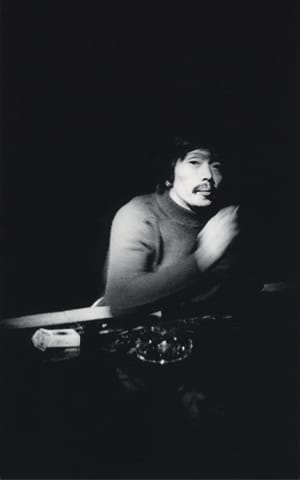
The New York Times
Saturday, December 9, 1967
Yuichiro Shibata (de Mena, 453 East 88th street) : Neat, often rather spare, and very pure, these paintings have somewhat the look of having been excised from some huge composition. The suggestion that as much is happening beyond their borders as within them probably accounts for the interest of these abstractions where a limited number of motifs are juggled and rejuggled with stylish dexterity.
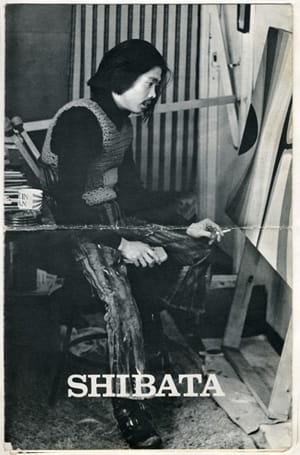
Arts Magazine
November 1971
The great fault of Freud lay in his reduction of art symbols to manifestations of sex only. A careful examination of Yuichiro Shibata’s canvases (Greer, Nov. 9-20) reveals a preoccupation with cosmic dislocation rather than sex. Recognizable symbols include atomic explosions, suns, moons, reversed Roman letters, curtains and artists’ canvases. Disruption of shapes along a central vertical line, as if the picture were cut in two with one half placed higher than the other, creates an effect of recession. Shibata says that this dislocation indicates a shift to another dimension, “like taking a trip,” as he jokingly puts it. It is certainly a way of suggesting three-dimensional space even though there is no hole and the picture plane covers everything. Ambiguous overlaps, that could be merely shapes lying beside one another, are numerous. Shibata’s colors are pleasing though strange-always appropriate to the rendering of cosmic space. This is a promising show for a man still in his twenties.
Daily American
Bright lights on white
Yuichiro Shibata is an artistic master of no color
Sunday – Monday, September, 1982
by Paul Feinberg
ROME – Japanese painter Yuichiro Shibata was born in 1945, four months before the historic bombing of Hiroshima. Despite the event’s enormity – dividing as it did Japan’s history into B.H. and A.H. periods – Shibata says it has no influence on his art. Instead, his artistic sensibilities were nurtured in his youth by Da Vinci and Van Gogh, whose works he studied as he passed many hours with pen and rice paper in hand.
Nippon University
At twelve years of age he precociously opted for a career in art, much to his family’s dismay. He ignored the disapproval and continued, eventually studying for a time at Nippon University under the tutelage of Rikio Nozaki, who was the first to speak to him with enthusiasm about Italy. Shibata traveled to New York in 1967 and there flowered not only his artistic abilities but also his attachment to Italian culture; an attachment that has now finally culminated with a trip to and show in Rome.
The Years between his arrival in New York and the present day were successful ones. He had a number of shows in different prominent New York galleries, including The Greer, Peter A. Berman and his most recent one in 1981 at Sergio Tosi’s Gallery on 57th street.
But even in New York Italian influences were not lacking, with names such as Burri, Fontana, Dorazio attracting his attention. Life consisted of music by Vivaldi and Scarletti, topped off by steaming plates of pasta served in Little Italy restaurants by waiters singing Celeste Aida. Now he is finally in Italy, free to explore his Italian “roots” inseminated more than 26 years ago in an Tokyo apartment.
If the artistic memories of his youth were centered around the images of the two European masters Da Vinci and Van Gogh, it was not the former’s perspective or the latter’s twisted figures which intrigued him. In Shibata’s eyes, the common factors between the Renaissance man and the Flemish peasant were the texture of the paint surface, the background colors, the rendering of rock and shrub and the swirls of turbulent sky. This interest in surface, light effects and texture have been his creative impetus until now and are prominent in his latest works.
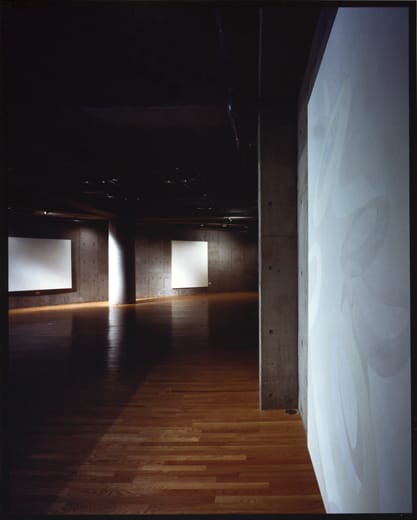
Whiteness
The first impression is of whiteness. Everything is “colorless” – the walls, the glaring helium lights and above all the paintings. Or so it seems. The lighting is at first so bright as to be a nuisance. But on second appraisal it seems to create a desirable if perhaps unintended effect.
Viewed from the front, the paintings are entirely washed out by light. In most of the works all that is apparent is a centrally placed polygon with a thin vertical line running though it from edge to edge. When viewed from the side, this lonely form in a grey field is discovered to be either an integral part of a larger mass or the negative space of a composition.
These “grey” canvases are large, between one and two and a half meters square, with thick stretcher edges necessitated by the scale. The paintings are done with a combination of oil and acrylic paints with the use of tape to create sharp edges. Various geometric forms are “shaded” by delicate touches of primary colors causing minimal gradation in white tones. Differences in texture, surface reflective quality and paint thickness are used to similar effect. These shades are the “colors” of Shibata’s palate.
Forced by the glaring lights to approach the painting’s surface from uncommon viewpoints, the process of discovery begins. To observe works of art from oblique angles is not as strange as may be thought. It is a common enough occurrence in museums and galleries where technical considerations or incompetence cause an unsightly glare on the surface of glass covered works. Here however such visual gymnastics are a necessity and a pleasure. The various shades of grey, which if viewed from the conventional distance and angle fade into one scarcely distinguishable mass, on close examination rise from the surface to become shapes of magnetic rhythm and monumental forms. Art spectators are accustomed to “see” paintings from a distance, usually while strolling haphazardly through the gallery’s space. Only a fastidious few really get in there and dig into the works with their eyes. If you want to understand this show, you become a “digger”.
And what you “mine” are mere glimpses of monolithic geometric forms which fall into or punch-out of the surface. Powerful yet transient images, making comparisons with the spaces of New York – Shibata’s “native” city – inevitable. The bird’s and ant’s eye views of towering sky-scrapes and yawning metal canyons are unmistakable. Not all the paintings are of monumental views, for there are geometric rhythms which swirl your eye in and out of the Piranesian interiors leading for as long as you can follow, then vanishing.
Certainly if Shibata wanted to create two-dimensional monuments to New York, it would be more obvious to manufacture huge airbrushed photo-realistic canvases where every pore and pimple of the city would stand out in flaring redness. Choosing however to impress subtly as opposed to blatantly, he encourages entrance into his paintings rather than simple awed observation. In this manner he brings the viewer into the emotional creation of the painting.
Town & Country Magazine
by Stefan Janis, 1995
Yuichiro Shibata is known for his straight line paintings of colored cubes and his white-on-white works, which have brought him critical acclaim. They were the subject of System to Non-Conclusion III, a show held at the important Fujii Gallery in Tokyo in 1991. With System to Non-Conclusion IV; Landscape of Life, his first exhibition in America in 13 years, it is the simple motif of the spiral in a series of planes that becomes his cause célebre. He actually started working in this style in 1988, but his paintings have not seen the light of day until now.
Shibata is a dedicated artist who had his first show at the De Mena Gallery in New York City when he was twenty-two years old. At that phase of his career he was intensely working with oil paintings of geometric, colored cubes which were set against either uniformly-colored, one-dimensional backgrounds. In 1972, he started painting his first white-on-white paintings in oil, which owe something to Malevich’s White on White. These are extremely meticulous works, which explore the vertical axis more than the horizontal one, and attempt to define space by allowing the canvas to protrude in subtle formations. Furthermore, viewing them from different angles, creates an odd sense of relocation vis-á-vis the work, so that one feels as if on the periphery of a maze. This style of his was first seen in New York City in 1975 at the Peter Berman Gallery.
The artist was born in Tokyo in 1945 and studied privately with the late Nozaki beginning at the age of nine. Nozaki was a student of Matisse in Paris and the first winner of the Viennale Grand Prix. Mr.Shibata also studied at Nippon University Art Department in Tokyo. He lives in New York City.
Why does Shibata call his works Landscape of Life? The artist explains it this way: “I have lots of things on my mind which I want to express with a different method and in a different media, but as long as I am a painter I want to do something brand new as a painting. Paintings are line and space and colors and shapes. When I look at the painting it seems to me it’s like a landscape. To me this spiral is just like a scene from the time I was born, as well as now and the future and beyond the future.”
Artists have always had signature pieces. Constable had the landscape, Sargent the portrait, Degas the ballet dancer and so on. In the field of contemporary art, it is much harder to succeed with acquiring a signature since we are dealing, for the most part, with abstract art, and not representational art. In the 20th century, Warhol succeeded with the Campbell Soup can, Jasper Johns succeeded with the American flag and numbers, Motherwell succeeded with the dialectic of opposites, that is to say straight lines, soft lines, etc… However, the spiral in a series of planes is not a motif that has made its way successfully into the field of contemporary painting and Mr.Shibata, if he gets his way, will make it his signature.
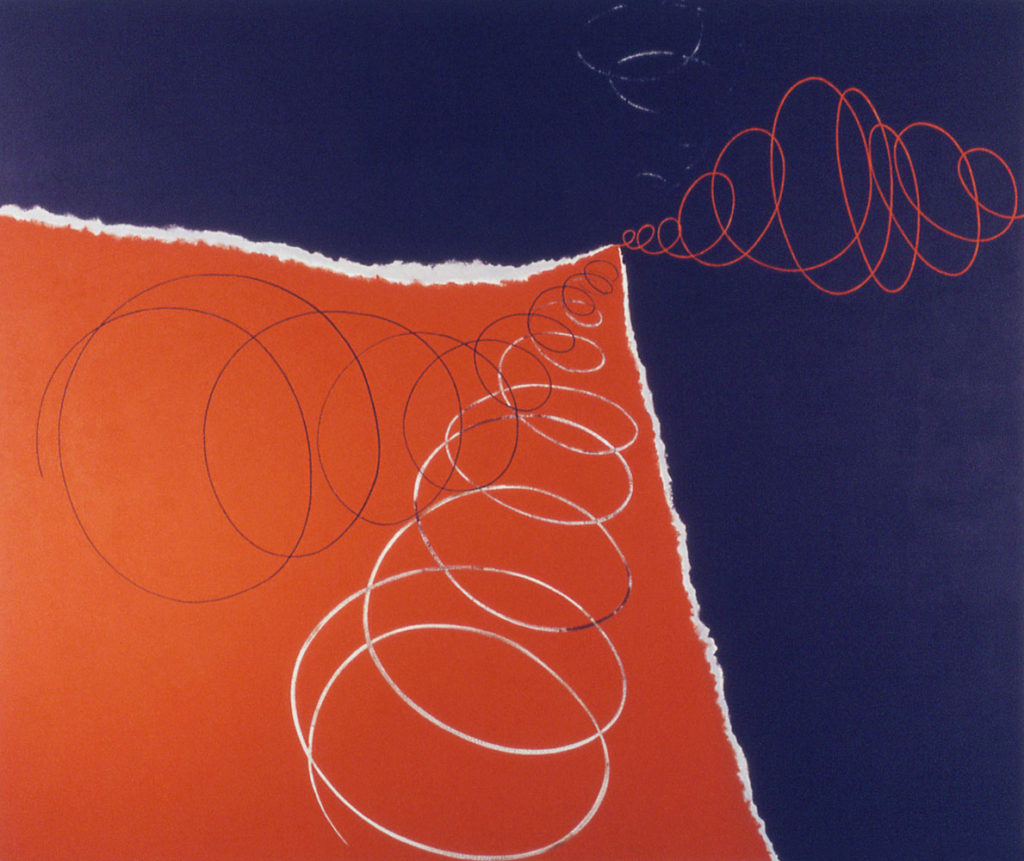
Landscape of Life Number 3, 1994
The spiral art of Shibata clearly has calligraphy at its root, the kind of calligraphic technique practiced as early as the 12th century A.D. in the West. Then, the motif was designed to be ornamental and decorative. But Mr. Shibata was intends his spirals to go beyond the merely decorative and become beacons to unsolved mysteries about the psychology of man. The artist’s brushstrokes seem to give a child’s simple form an incalculable optimism and painterly esthetic. The reasons are basically threefold: 1) the technique 2) the colors and 3) the philosophy of the painter.
First, the spirals are not all of the same color. They are not all drawn over Shibata’s bright palette of colors; but in many instances the spirals are drawn first, then the background color is applied around the spiral, which creates the effect of a recessed spiral. This leads to an optic stimulation that makes the viewer curious to see the canvas from more than one angle.
There is one painting that incorporates the white-on-white style. It features two large black spirals on a white background, which meet at the point of infinity, from which emanates another spiral – this time white in color and still against the white background. Philosophically speaking, the artist seems to be asking the question: “When one reaches the point of infinity, it is not possible that we merely have to travel to another dimension?”
In another work one sees how the artist lets the canvas show through for cloud-like effects, and how skillfully he combines bright hues with a black spiral for diorama-like effects. Here the sense of landscape is imminent, the sense one is viewing a scene from outside one’s front or inner door is made extremely, apparent. A large part of this success can be attributed to the fact that the artist, who uses almost exclusively acrylic paints, does not restrict himself to primary colors, but colors of such intensity that the subtleties of applying the spirals and combining the colors become all the more riveting.
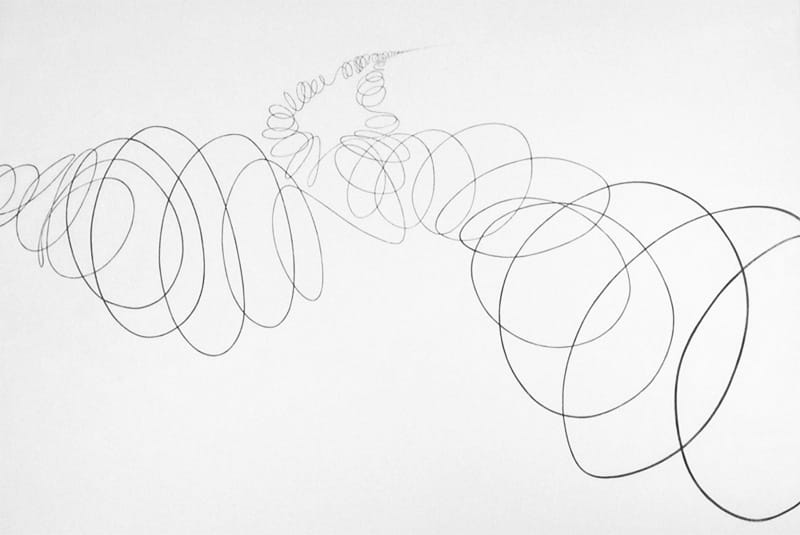
Locus of Time : System to Non-Conclusion IV, 1995
One could interpret the spirals Shibata paint as representing everything from elements like the wind to the activity associated with emerging from an embryo.
They could also be interpreted as sound waves, an idea that given his background and tastes might not be so far off the mark. His mother plays the ancient Japanese instrument, the Koto, and his sister is a classical pianist. By his own admission, he says he loves jazz and that its improvisatory techniques appeal to him. But the point of Shibata’s spirals is not so much a question of discovering their inspiration as it is to be galvanized into a curiosity about our own lives, into asking questions, about the future and maybe even assessing the possibility that alien life might exist.